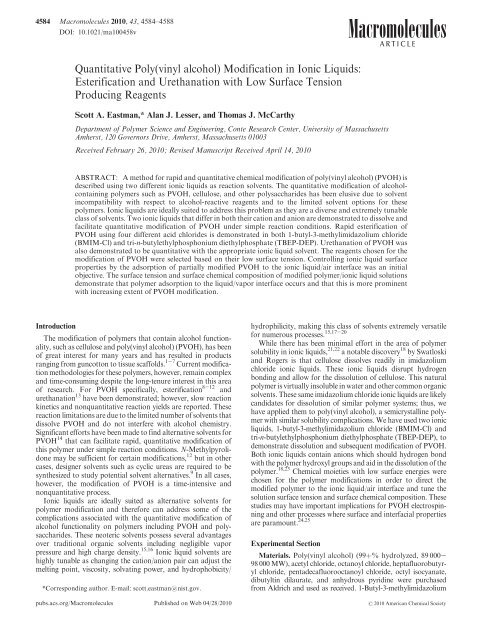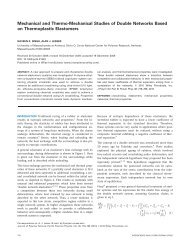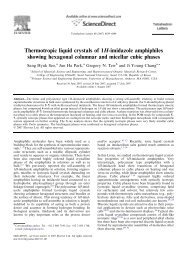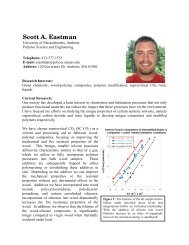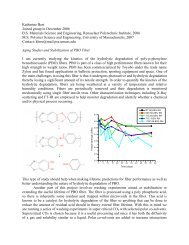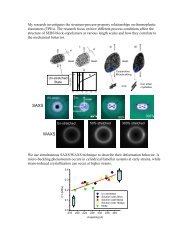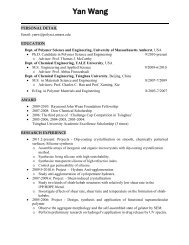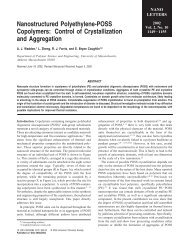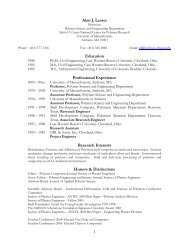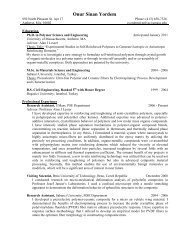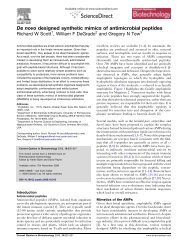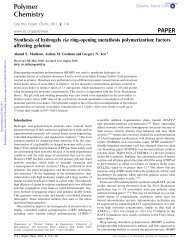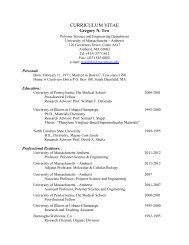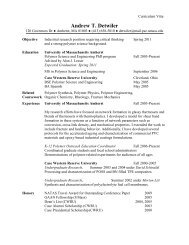Quantitative Poly (vinyl alcohol) Modification in Ionic Liquids ...
Quantitative Poly (vinyl alcohol) Modification in Ionic Liquids ...
Quantitative Poly (vinyl alcohol) Modification in Ionic Liquids ...
- No tags were found...
Create successful ePaper yourself
Turn your PDF publications into a flip-book with our unique Google optimized e-Paper software.
4584 Macromolecules 2010, 43, 4584–4588DOI: 10.1021/ma100458v<strong>Quantitative</strong> <strong>Poly</strong>(<strong>v<strong>in</strong>yl</strong> <strong>alcohol</strong>) <strong>Modification</strong> <strong>in</strong> <strong>Ionic</strong> <strong>Liquids</strong>:Esterification and Urethanation with Low Surface TensionProduc<strong>in</strong>g ReagentsScott A. Eastman,* Alan J. Lesser, and Thomas J. McCarthyDepartment of <strong>Poly</strong>mer Science and Eng<strong>in</strong>eer<strong>in</strong>g, Conte Research Center, University of MassachusettsAmherst, 120 Governors Drive, Amherst, Massachusetts 01003Received February 26, 2010; Revised Manuscript Received April 14, 2010ABSTRACT: A method for rapid and quantitative chemical modification of poly(<strong>v<strong>in</strong>yl</strong> <strong>alcohol</strong>) (PVOH) isdescribed us<strong>in</strong>g two different ionic liquids as reaction solvents. The quantitative modification of <strong>alcohol</strong>conta<strong>in</strong><strong>in</strong>gpolymers such as PVOH, cellulose, and other polysaccharides has been elusive due to solvent<strong>in</strong>compatibility with respect to <strong>alcohol</strong>-reactive reagents and to the limited solvent options for thesepolymers. <strong>Ionic</strong> liquids are ideally suited to address this problem as they are a diverse and extremely tunableclass of solvents. Two ionic liquids that differ <strong>in</strong> both their cation and anion are demonstrated to dissolve andfacilitate quantitative modification of PVOH under simple reaction conditions. Rapid esterification ofPVOH us<strong>in</strong>g four different acid chlorides is demonstrated <strong>in</strong> both 1-butyl-3-methylimidazolium chloride(BMIM-Cl) and tri-n-butylethylphosphonium diethylphosphate (TBEP-DEP). Urethanation of PVOH wasalso demonstrated to be quantitative with the appropriate ionic liquid solvent. The reagents chosen for themodification of PVOH were selected based on their low surface tension. Controll<strong>in</strong>g ionic liquid surfaceproperties by the adsorption of partially modified PVOH to the ionic liquid/air <strong>in</strong>terface was an <strong>in</strong>itialobjective. The surface tension and surface chemical composition of modified polymer/ionic liquid solutionsdemonstrate that polymer adsorption to the liquid/vapor <strong>in</strong>terface occurs and that this is more prom<strong>in</strong>entwith <strong>in</strong>creas<strong>in</strong>g extent of PVOH modification.IntroductionThe modification of polymers that conta<strong>in</strong> <strong>alcohol</strong> functionality,such as cellulose and poly(<strong>v<strong>in</strong>yl</strong> <strong>alcohol</strong>) (PVOH), has beenof great <strong>in</strong>terest for many years and has resulted <strong>in</strong> productsrang<strong>in</strong>g from guncotton to tissue scaffolds. 1-7 Current modificationmethodologies for these polymers, however, rema<strong>in</strong> complexand time-consum<strong>in</strong>g despite the long-tenure <strong>in</strong>terest <strong>in</strong> this areaof research. For PVOH specifically, esterification 8-12 andurethanation 13 have been demonstrated; however, slow reactionk<strong>in</strong>etics and nonquantitative reaction yields are reported. Thesereaction limitations are due to the limited number of solvents thatdissolve PVOH and do not <strong>in</strong>terfere with <strong>alcohol</strong> chemistry.Significant efforts have been made to f<strong>in</strong>d alternative solvents forPVOH 14 that can facilitate rapid, quantitative modification ofthis polymer under simple reaction conditions. N-Methylpyrolidonemay be sufficient for certa<strong>in</strong> modifications, 12 but <strong>in</strong> othercases, designer solvents such as cyclic ureas are required to besynthesized to study potential solvent alternatives. 9 In all cases,however, the modification of PVOH is a time-<strong>in</strong>tensive andnonquantitative process.<strong>Ionic</strong> liquids are ideally suited as alternative solvents forpolymer modification and therefore can address some of thecomplications associated with the quantitative modification of<strong>alcohol</strong> functionality on polymers <strong>in</strong>clud<strong>in</strong>g PVOH and polysaccharides.These neoteric solvents possess several advantagesover traditional organic solvents <strong>in</strong>clud<strong>in</strong>g negligible vaporpressure and high charge density. 15,16 <strong>Ionic</strong> liquid solvents arehighly tunable as chang<strong>in</strong>g the cation/anion pair can adjust themelt<strong>in</strong>g po<strong>in</strong>t, viscosity, solvat<strong>in</strong>g power, and hydrophobicity/*Correspond<strong>in</strong>g author. E-mail: scott.eastman@nist.gov.hydrophilicity, mak<strong>in</strong>g this class of solvents extremely versatilefor numerous processes. 15,17-20While there has been m<strong>in</strong>imal effort <strong>in</strong> the area of polymersolubility <strong>in</strong> ionic liquids, 21,22 a notable discovery 18 by Swatloskiand Rogers is that cellulose dissolves readily <strong>in</strong> imidazoliumchloride ionic liquids. These ionic liquids disrupt hydrogenbond<strong>in</strong>g and allow for the dissolution of cellulose. This naturalpolymer is virtually <strong>in</strong>soluble <strong>in</strong> water and other common organicsolvents. These same imidazolium chloride ionic liquids are likelycandidates for dissolution of similar polymer systems; thus, wehave applied them to poly(<strong>v<strong>in</strong>yl</strong> <strong>alcohol</strong>), a semicrystall<strong>in</strong>e polymerwith similar solubility complications. We have used two ionicliquids, 1-butyl-3-methylimidazolium chloride (BMIM-Cl) andtri-n-butylethylphosphonium diethylphosphate (TBEP-DEP), todemonstrate dissolution and subsequent modification of PVOH.Both ionic liquids conta<strong>in</strong> anions which should hydrogen bondwith the polymer hydroxyl groups and aid <strong>in</strong> the dissolution of thepolymer. 18,23 Chemical moieties with low surface energies werechosen for the polymer modifications <strong>in</strong> order to direct themodified polymer to the ionic liquid/air <strong>in</strong>terface and tune thesolution surface tension and surface chemical composition. Thesestudies may have important implications for PVOH electrosp<strong>in</strong>n<strong>in</strong>gand other processes where surface and <strong>in</strong>terfacial propertiesare paramount. 24,25Experimental SectionMaterials. <strong>Poly</strong>(<strong>v<strong>in</strong>yl</strong> <strong>alcohol</strong>) (99þ% hydrolyzed, 89 000-98 000 MW), acetyl chloride, octanoyl chloride, heptafluorobutyrylchloride, pentadecafluorooctanoyl chloride, octyl isocyanate,dibutylt<strong>in</strong> dilaurate, and anhydrous pyrid<strong>in</strong>e were purchasedfrom Aldrich and used as received. 1-Butyl-3-methylimidazoliumpubs.acs.org/Macromolecules Published on Web 04/28/2010 r 2010 American Chemical Society
Article Macromolecules, Vol. 43, No. 10, 2010 4585Figure 1. Esterifications and urethanation carried out on PVOH <strong>in</strong>ionic liquids.chloride (BMIM-Cl) was purchased from Fluka Chemical Co.,dried at reduced pressure and 80 °C for 48 h, and stored <strong>in</strong> a sealedround-bottom flask under a positive pressure of dry nitrogenuntil needed. Tri-n-butylethylphosphonium diethylphosphate(TBEP-DEP) was donated by Cytec and purified as per theprocedures for BMIM-Cl.Preparation of <strong>Poly</strong>(<strong>v<strong>in</strong>yl</strong> <strong>alcohol</strong>)/<strong>Ionic</strong> Liquid Solutions.Solid PVOH (1.0 wt %) was added to 20 mL sc<strong>in</strong>tillation vialsconta<strong>in</strong><strong>in</strong>g ionic liquid and a magnetic stir bar. The vials werecapped with rubber septa and purged with dry nitrogen throughoutthe polymer dissolution process to remove any residualwater from the polymer/ionic liquid solution. The mixture wasallowed to stir at 90 °C for 18-48 h or until the PVOH was fullydissolved. It is important to note that 1.0 wt % PVOH solutionswere used <strong>in</strong> order to m<strong>in</strong>imize solution viscosity, and it is notthe limit for polymer solubility <strong>in</strong> the ionic liquids. Solutions ashigh as 10.0 wt % PVOH <strong>in</strong> both BMIM-Cl and TBEP-DEPhave been prepared and determ<strong>in</strong>ed to be completely miscible byvisual <strong>in</strong>spection. These solutions are extremely viscous, mak<strong>in</strong>git difficult to perform dynamic light scatter<strong>in</strong>g measurements ormodifications via magnetic stirr<strong>in</strong>g at the temperatures def<strong>in</strong>edsubsequently. Higher concentrations than 10.0 wt % PVOH <strong>in</strong>BMIM-Cl and TBEP-DEP may be accessible us<strong>in</strong>g the dissolutiontechniques demonstrated for cellulose by Swatloski et al. 18The prepared PVOH solutions were used immediately afterthe polymer was completely dissolved to avoid absorption ofwater <strong>in</strong>to the solution. Dynamic light scatter<strong>in</strong>g was carried outon each polymer/ionic liquid solution as well as a 1 wt % water/PVOH solution to confirm the dissolution of PVOH <strong>in</strong> therespective solvent (see Support<strong>in</strong>g Information Figures S1-S4).Hydrodynamic radii of 10.9 and 5.5 nm were measured for1 wt % PVOH/water solutions and 1 wt % TBEP-DEP solutions,respectively. Light scatter<strong>in</strong>g experiments for PVOH/BMIM-Clsolution were <strong>in</strong>conclusive as the solutions fluoresce under the<strong>in</strong>cident beam. Visual transparency and <strong>in</strong>creased solution viscosity,however, imply that the PVOH is dissolved <strong>in</strong> BMIM-Cl(see the Support<strong>in</strong>g Information for further details).Esterification of <strong>Poly</strong>(<strong>v<strong>in</strong>yl</strong> <strong>alcohol</strong>) <strong>in</strong> <strong>Ionic</strong> Liquid Solvents.Esterification of PVOH was carried out us<strong>in</strong>g four different acidchlorides (Figure 1). A particular fraction of the stoichiometricamount (relative to hydroxyl groups) of the acid chloride was<strong>in</strong>troduced to a PVOH/ionic liquid solution to obta<strong>in</strong> a specifiedextent of polymer modification. All reactions were carried out at90 °C with constant stirr<strong>in</strong>g unless otherwise specified. The onlydifference <strong>in</strong> the reaction conditions for the different ionic liquidsolutions was the time allotted for the reactions to take place.PVOH/TBEP-DEP solutions were allowed to react for 1 h,whereas PVOH/BMIM-Cl solutions were allowed to react for10-15 m<strong>in</strong> as the reactions were found to reach full conversion<strong>in</strong> these allotted times. Reactions were carried out both with andwithout pyrid<strong>in</strong>e, a typical esterification catalyst and acidscavenger, and it was determ<strong>in</strong>ed that addition of catalyst didnot affect the reaction k<strong>in</strong>etics. The result<strong>in</strong>g polymer productswere precipitated from the ionic liquid with a nonsolvent whichvaried depend<strong>in</strong>g on the extent of modification. Water was usedto precipitate PVOH modified above 50%, while chloroformwas used for PVOH modified below 50%. The precipitate wasisolated by centrifugation and washed three times with anappropriate nonsolvent to remove residual ionic liquid. Thepolymer was then dried at reduced pressure and 60 °C and stored<strong>in</strong> sealed sc<strong>in</strong>tillation vials.Urethanation of <strong>Poly</strong>(<strong>v<strong>in</strong>yl</strong> <strong>alcohol</strong>) <strong>in</strong> <strong>Ionic</strong> Liquid Solvents.Urethanation of PVOH was carried out us<strong>in</strong>g octyl isocyanate<strong>in</strong> a manner similar to the esterification reactions mentionedpreviously (Figure 1). A particular fraction of the stoichiometricamount of octyl isocyanate was <strong>in</strong>troduced <strong>in</strong>to the PVOH/ionicliquid solutions to obta<strong>in</strong> the desired extent of polymer modification.These reactions were carried out both with and withoutdibutylt<strong>in</strong> dilaurate, a typical urethanation catalyst. Allreactions were carried out at 90 °C with constant stirr<strong>in</strong>g andwere allowed to react for 18-24 h. <strong>Poly</strong>mer isolation andpurification methods were identical to those described for thesynthesis of the polyesters mentioned previously.Characterization of Isolated, Modified PVOH. All isolatedpolymer products were analyzed by attenuated total reflectance<strong>in</strong>frared (ATR-IR) spectroscopy us<strong>in</strong>g a HORIBA Job<strong>in</strong> YvonHR800 spectrometer equipped with an ATR-IR lens and X-rayphotoelectron spectroscopy (XPS) us<strong>in</strong>g a Quantum 2000 scann<strong>in</strong>gESCA microprobe (Physical Electronics). 100% modified,unfluor<strong>in</strong>ated polymers were found to redissolve <strong>in</strong> chloroformand were analyzed by nuclear magnetic resonance spectroscopy(NMR) us<strong>in</strong>g a Bruker-Spectrosp<strong>in</strong> 300 Hz nuclear magneticresonance spectrometer. All other polymer products were <strong>in</strong>soluble<strong>in</strong> typical NMR solvents.Preparation of Modified <strong>Poly</strong>mer/<strong>Ionic</strong> Liqud Solutions forSurface Characterization. Partially modified PVOH/ionic liquidsolutions were prepared <strong>in</strong> the same manner as described previously,except that the polymer was not isolated. Instead, thepolymer was left <strong>in</strong> solution, and the entire solution was driedunder reduced pressure at 60 °C for 18 h. These solutions werethen sealed under dry nitrogen until surface characterizationexperiments were carried out.Surface Characterization of <strong>Ionic</strong> <strong>Liquids</strong> and <strong>Poly</strong>mer/<strong>Ionic</strong>Liquid Solutions. The surface activity of partially modifiedPVOH was analyzed by study<strong>in</strong>g the surface tension and surfacechemical composition of all polymer/ionic liquid solutions as afunction of extent of polymer modification. The chemicalcompositions of all ionic liquids and polymer/ionic liquid solutionswere determ<strong>in</strong>ed by X-ray photoelectron spectroscopyanalysis. Surface tension was determ<strong>in</strong>ed by the Wilhelmy platemethod us<strong>in</strong>g a Langmuir-Blodgett tensiometer equipped witha microbalance and a cyl<strong>in</strong>drical steel probe. The tensiometerwas calibrated by tar<strong>in</strong>g the microbalance with the probesuspended <strong>in</strong> air and subsequently plac<strong>in</strong>g the probe <strong>in</strong> deionizedwater to measure the tensile force on the probe. This forcewas calibrated to a surface tension of 72.8 dyn/cm. The probewas then moved to the desired solution, and the surface tensionwas recorded. The probe was cleaned after each measurement bywash<strong>in</strong>g with copious amounts of distilled water and placed on adrop of distilled water aga<strong>in</strong> to ensure that the probe was notcontam<strong>in</strong>ated. If the surface tension of the distilled water did notread 72.8 ( 0.5 dyn/cm, the probe was cleaned by plac<strong>in</strong>g it overa Fisher burner.Results and DiscussionEsterification of PVOH <strong>in</strong> <strong>Ionic</strong> <strong>Liquids</strong>. The modificationof poly(<strong>v<strong>in</strong>yl</strong> <strong>alcohol</strong>) was carried out with the acid chlorides
4586 Macromolecules, Vol. 43, No. 10, 2010 Eastman et al.Figure 2. ATR-IR spectra of aliphatic acid chloride-modified poly-(<strong>v<strong>in</strong>yl</strong> <strong>alcohol</strong>).Figure 3. ATR-IR spectra of perfluor<strong>in</strong>ated acid chloride-modifiedpoly(<strong>v<strong>in</strong>yl</strong> <strong>alcohol</strong>).shown <strong>in</strong> Figure 1, and we refer to the result<strong>in</strong>g polyesters bytheir associated roman numeral and correspond<strong>in</strong>g extent ofmodification (for example, I-100 refers to 100% theoreticalconversion,acetylchloride-modified PVOH) . Esterificationscarried out <strong>in</strong> BMIM-Cl were run both with and withoutpyrid<strong>in</strong>e catalysis to determ<strong>in</strong>e if there was any apparentdifference <strong>in</strong> the reaction k<strong>in</strong>etics. All modification reactionswere completed <strong>in</strong> less than 15 m<strong>in</strong> regardless of catalystload<strong>in</strong>g; thus, BMIM-Cl is assumed to act as a catalyz<strong>in</strong>gsolvent for this reaction. IR analysis of the result<strong>in</strong>g polyesterssuggests the complete conversion of the hydroxyl groups ofPVOH to ester groups with<strong>in</strong> 15 m<strong>in</strong> at 90 °C without pyrid<strong>in</strong>ecatalyst. In Figures 2 and 3 it is apparent that the -OHstretch<strong>in</strong>g vibration at 3200 cm -1 <strong>in</strong> the unmodified PVOHhas completely disappeared, and prom<strong>in</strong>ent carbonyl stretch<strong>in</strong>gis observed at 1730 cm -1 . PVOH samples that weremodified with perfluor<strong>in</strong>ated acid chlorides also show C-Fstretch<strong>in</strong>g at 1200 and 1150 cm -1 , characteristic of trifluoromethyland difluoromethylene groups, respectively (Figure 3).Figure 4. 1 H NMR spectrum of (a) acetyl chloride-modified PVOH(I-100, 100% conversion), (b) octanoyl chloride-modified PVOH (II-100, 95% conversion), and (c) octyl isocyanate-modified PVOH (V-100,100% conversion).The 100% modification of PVOH with acetyl chloride wasfurther confirmed by NMR, whereas the modification ofoctanoyl chloride reached a conversion of 95% as calculated
Article Macromolecules, Vol. 43, No. 10, 2010 4587by the <strong>in</strong>tegration from Figure 4. Integration of the peaksnear 5.0 ppm for each result<strong>in</strong>g polyester were comparedwith the peaks between 1.5 and 2.2 ppm and the peak at 2.3ppm for I-100 and II-100, respectively, to determ<strong>in</strong>e percentconversion. While esterifications of PVOH with acid chlorideshave been reported on, it is extremely difficult to obta<strong>in</strong>reaction yields of PVOH higher than 95%, and lengthyreaction times are necessary to reach these conversions. 26The simple reaction conditions established for the esterificationof PVOH <strong>in</strong> BMIM-Cl result <strong>in</strong> conversions g95%with<strong>in</strong> 10-15 m<strong>in</strong>. In addition, Figure 5 illustrates that thedesired extent of modification can be easily controlled bysimply add<strong>in</strong>g the appropriate molar ratio of acid chloride to<strong>alcohol</strong>.The esterification of PVOH <strong>in</strong> TBEP-DEP was alsocarried out and easily controlled, reach<strong>in</strong>g similar conversionsas demonstrated <strong>in</strong> BMIM-Cl. The reaction k<strong>in</strong>eticsare only slightly slower than <strong>in</strong> BMIM-Cl as completeconversion of PVOH to the desired polyester can be obta<strong>in</strong>edwithout pyrid<strong>in</strong>e catalysis <strong>in</strong> about 1 h at 90 °C. There aretwo advantages <strong>in</strong> us<strong>in</strong>g TBEP-DEP over BMIM-Cl. First,BMIM-Cl has a melt<strong>in</strong>g po<strong>in</strong>t around 70 °C, requir<strong>in</strong>gelevated temperatures to dissolve PVOH and carry out thesereactions, whereas TBEP-DEP is a liquid at room temperatureand is therefore able to dissolve PVOH at room temperature,albeit very slowly. Second, complete conversion ofPVOH to the desired polyester can be obta<strong>in</strong>ed at roomtemperature with<strong>in</strong> 18 h. This allows for an added level ofcontrollability when chemically modify<strong>in</strong>g PVOH as thereaction k<strong>in</strong>etics can be tuned by adjust<strong>in</strong>g the temperatureof the reaction from room temperature to 90 °C and above.Urethanation of PVOH <strong>in</strong> <strong>Ionic</strong> <strong>Liquids</strong>. Urethanation ofPVOH carried out <strong>in</strong> TBEP-DEP resulted <strong>in</strong> quantitative,controllable conversion to the result<strong>in</strong>g polyurethane. Thereaction k<strong>in</strong>etics are significantly slower (48 h at 90 °C) thanthe previously discussed esterification reactions, however,and the addition of dibutylt<strong>in</strong> dilaurate catalyst is required.IR spectroscopy suggests the quantitative and controllableconversion of PVOH to the result<strong>in</strong>g polyurethanes (Figure 6).The broad -OH band at 3200 cm -1 decreases <strong>in</strong> <strong>in</strong>tensityas the narrower N-H peak at 3325 cm -1 <strong>in</strong>creases <strong>in</strong><strong>in</strong>tensity with an <strong>in</strong>creased extent of modification. As moreurethane l<strong>in</strong>kages are formed, the appearance of the othercarbamate IR characteristics at 1578, 1612, and 1690 cm -1are also apparent. The first two representative carbamatepeaks are associated with the carbamate C-N and C-O,respectively, and the third peak is associated with the CdOstretch.The NMR spectrum of the result<strong>in</strong>g octyl isocyanatepolyurethane shown <strong>in</strong> Figure 4c confirms the 100% modificationconversion from PVOH; however, one discrepancy<strong>in</strong> the spectrum is the absence of the peak for the N-Hproton, which should appear typically between 5 and 6 ppm.The absence of this peak may be due to the rapid protonassociation/dissociation rate typical of this acidic carbamateproton. Integration of the peak near 4.3 ppm was comparedwith the peak at 3.2 ppm to determ<strong>in</strong>e percent conversion.Urethanation of PVOH with octyl isocyanate was alsoattempted <strong>in</strong> BMIM-Cl; however, this solvent proved to be apoor reaction medium for urethanations as little to noreaction occurred.Surface Analysis of <strong>Ionic</strong> Liquid and <strong>Poly</strong>mer/<strong>Ionic</strong> LiquidSolution Surfaces. The surface activity of partially modifiedPVOH was studied by measur<strong>in</strong>g changes <strong>in</strong> surface tensionand chemical composition of ionic liquid/polymer solutionsat various extents of modification. Table 1 summarizes thesurface tension and chemical composition of the pure ionicliquid and the ionic liquid/polymer solutions before andafter modification of PVOH. The nam<strong>in</strong>g scheme is the sameas the previous modifications. The roman numeral <strong>in</strong>dicatesthe modify<strong>in</strong>g reagent, and the number <strong>in</strong>dicates estimatedpolymer conversion based on the stoichiometric amountof reagent added to the solution. The denotation, “sol”,<strong>in</strong>dicates that the modified polymers were not isolated fromthe ionic liquid and left <strong>in</strong> solution for surface tensionFigure 5. ATR-IR spectra of PVOH modified to vary<strong>in</strong>g extents withoctanoyl chloride.Figure 6. ATR-IR spectra of PVOH modified to various extents withoctyl isocyanate.Table 1. Surface Tension and XPS Atomic Composition Data for <strong>Ionic</strong> Liquid/<strong>Poly</strong>mer Solutionssample surface tension (dyn/cm) C (%) F (%) O (%) N (%) Cl (%)pure BMIM-Cl 44.5 75.0
4588 Macromolecules, Vol. 43, No. 10, 2010 Eastman et al.measurements. The <strong>in</strong>corporation of 1 wt % PVOH <strong>in</strong>BMIM-Cl does not appreciably change the surface tensionof pure BMIM-Cl; however, m<strong>in</strong>imal esterification witheither octanoyl chloride or perfluorooctanoyl chloride drasticallyreduces the surface tension of the ionic liquid. Perfluorooctanoylsubstituents, hav<strong>in</strong>g the lower surface energy,decreases the surface tension to a greater extent than theoctanoyl moiety. In addition, <strong>in</strong>creas<strong>in</strong>g the extent of modificationalso decreases the surface tension further and<strong>in</strong>creases the fluor<strong>in</strong>e content at the ionic liquid/air <strong>in</strong>terfacefor perfluor<strong>in</strong>ated octanoyl chloride-modified PVOH(Table 1).The observed trends for surface tension and chemicalcomposition are expected of low surface energy moieties thatare adsorbed to the liquid/air <strong>in</strong>terface; however, there aretwo possible scenarios that could expla<strong>in</strong> these same observations.One scenario is that the partially modified PVOH isadsorbed to the <strong>in</strong>terface as <strong>in</strong>tended. An alternative possibilityis that the adsorbed material is a m<strong>in</strong>iscule fraction ofimpurity or unreacted reagent that is present <strong>in</strong> the sample,lead<strong>in</strong>g to the same expected observations. While it may bepossible that the reduction <strong>in</strong> surface tension is due to animpurity, we believe that it is, <strong>in</strong> fact, the partially modifiedpolymer that is contribut<strong>in</strong>g to the observed surface characteristicsfor two reasons. First, we have shown that for theisolated, modified polymers all esterifications of PVOH arequantitative and complete with<strong>in</strong> 15 m<strong>in</strong>, suggest<strong>in</strong>g m<strong>in</strong>imalside reactions, and that unreacted reagent should not bepresent. Second, XPS is a high-vacuum technique typicallylimited to the analysis of solid samples. Typically liquids,organic small molecules, and moieties with an appreciablevapor pressure would be removed at the work<strong>in</strong>g pressureswith<strong>in</strong> the XPS <strong>in</strong>strument (10 -6 -10 -8 Torr). This suggeststhat a small molecule impurity is not likely. <strong>Ionic</strong> liquids, onthe other hand, have a negligible vapor pressure thus can beanalyzed under high-vacuum techniques.Conclusions1-Butyl-3-methylimidazolium chloride and tri-n-butylethylphosphoniumdiethylphosphate have been found to be viablesolvents and <strong>in</strong>ert reaction media for the modification of poly-(<strong>v<strong>in</strong>yl</strong> <strong>alcohol</strong>) under simple reaction conditions. The solubility ofPVOH <strong>in</strong> TBEP-DEP is confirmed by dynamic light scatter<strong>in</strong>g.Although the dynamic light scatter<strong>in</strong>g results for 1% PVOH/BMIM-Cl are <strong>in</strong>conclusive, we are certa<strong>in</strong> that PVOH is alsosoluble <strong>in</strong> BMIM-Cl. Both BMIM-Cl and TBEP-DEP weredemonstrated to facilitate the quantitative esterification ofPVOH without the aid of additional catalyst. The reactionk<strong>in</strong>etics of the esterification reactions presented here are significantlyfaster than previously reported <strong>in</strong> the literature, as completeconversion can be achieved <strong>in</strong> under 15 m<strong>in</strong> <strong>in</strong> BMIM-Cl.While esterifications are slightly slower <strong>in</strong> TBEP-DEP (1 h), morecontrollability over the esterification reaction can be achieved asthis solvent has a lower melt<strong>in</strong>g po<strong>in</strong>t than BMIM-Cl and canaccommodate lower reaction temperatures and thus slowerreaction rates.<strong>Quantitative</strong> urethanation of PVOH has also been achieved <strong>in</strong>TBEP-DEP with reaction times comparable to current literature.BMIM-Cl did not, however, accommodate urethanation ofPVOH under the specified reaction conditions.The broader purpose of partially modify<strong>in</strong>g PVOH with lowsurface energy substituents was to assess the surface activity ofthe result<strong>in</strong>g modified polymers <strong>in</strong> solution. Initial results <strong>in</strong>dicatethat we have systematically lowered the surface tension andmanipulated the surface chemical composition of the modifiedpolymer/ionic liquid solution by vary<strong>in</strong>g the chemical compositionand the extent of modification of the partially modifiedPVOH.Acknowledgment. We thank the NSF-sponsored MaterialsResearch Science and Eng<strong>in</strong>eer<strong>in</strong>g Center at the University ofMassachusetts for support.Support<strong>in</strong>g Information Available: A method used to analyzePVOH solutions via dynamic light scatter<strong>in</strong>g <strong>in</strong> water and <strong>in</strong>TBEP-DEP <strong>in</strong>dicates that the PVOH is soluble <strong>in</strong> each solvent ata 1 wt % concentration; a hydrodynamic radius of PVOH wasdeterm<strong>in</strong>ed for each solution. This material is available free ofcharge via the Internet at http://pubs.acs.org.References and Notes(1) Anon Nature 1909, 81, 144–147.(2) Bhargav, P. B.; Mohan, V. M.; Sharma, A. K.; Rao, V. J. Appl.<strong>Poly</strong>m. Sci. 2008, 108, 510–517.(3) Lyoo, W. S.; Ha, W. S. J. <strong>Poly</strong>m. Sci., Part A: <strong>Poly</strong>m. Chem. 1997,35, 55–67.(4) Koski, A.; Yim, K.; Shivkumar, S. Mater. Lett. 2004, 58, 493–497.(5) Hansen, E. W.; Holm, K. H.; Jahr, D. M.; Olafsen, K.; Stori, A.<strong>Poly</strong>mer 1997, 38, 4863–4871.(6) Lee, K. Y.; Mooney, D. J. Chem. Rev. 2001, 101, 1869–1879.(7) Willcox, P. J.; Howie, D. W.; Schmidt-Rohr, K.; Hoagland, D. A.;Gido, S. P.; Pudjijanto, S.; Kle<strong>in</strong>er, L. W.; Venkatraman, S.J. <strong>Poly</strong>m. Sci., Part B: <strong>Poly</strong>m. Phys. 1999, 37, 3438–3454.(8) Gimenez, V.; Mantecon, A.; Cadiz, V. J. <strong>Poly</strong>m. Sci., Part A:<strong>Poly</strong>m. Chem. 1996, 34, 925–934.(9) Fernandez, M. D.; Fernandez, M. J. J. Appl. <strong>Poly</strong>m. Sci. 2008, 107,2509–2519.(10) Saikia, C. N.; Tosh, B.; Dass, N. N. J. <strong>Poly</strong>m. Mater. 2000, 17,41–45.(11) Chetri, P.; Dass, N. N. J. Appl. <strong>Poly</strong>m. Sci. 2001, 81, 1182–1186.(12) Fernandez, M. D.; Fernandez, M. J.; Hoces, P. J. Appl. <strong>Poly</strong>m. Sci.2006, 102, 5007–5017.(13) Kim, C. K.; Kim, B. S.; Sheikh, F. A.; Lee, U. S.; Khil, M. S.; Kim,H. Y. Macromolecules 2007, 40, 4823–4828.(14) Chetri, P.; Dass, N. N. J. <strong>Poly</strong>m. Mater. 1998, 15, 51–55.(15) Huddleston, J. G.; Visser, A. E.; Reichert, W. M.; Willauer, H. D.;Broker, G. A.; Rogers, R. D. Green Chem. 2001, 3, 156–164.(16) Bonhote, P.; Dias, A. P.; Papageorgiou, N.; Kalyanasundaram, K.;Gratzel, M. Inorg. Chem. 1996, 35, 1168–1178.(17) Seddon, K. R. J. Chem. Technol. Biotechnol. 1997, 68, 351–356.(18) Swatloski, R. P.; Spear, S. K.; Holbrey, J. D.; Rogers, R. D. J. Am.Chem. Soc. 2002, 124, 4974–4975.(19) Marsh, K. N.; Boxall, J. A.; Lichtenthaler, R. Fluid Phase Equilib.2004, 219, 93–98.(20) Chiappe, C.; Pieracc<strong>in</strong>i, D. J. Phys. Org. Chem. 2005, 18, 275–297.(21) W<strong>in</strong>terton, N. J. Mater. Chem. 2006, 16, 4281–4293.(22) Snedden, P.; Cooper, A. I.; Scott, K.; W<strong>in</strong>terton, N. Macromolecules2003, 36, 4549–4556.(23) Calzia, K. J.; Forcum, A.; Lesser, A. J. J. Appl. <strong>Poly</strong>m. Sci. 2006,102, 4606–4615.(24) Viswanathan, G.; Murugesan, S.; Pushparaj, V.; Nalamasu, O.;Ajayan, P. M.; L<strong>in</strong>hardt, R. J. Biomacromolecules 2006, 7, 415–418.(25) Xu, S. S.; Zhang, J.; He, A. H.; Li, J. X.; Zhang, H.; Han, C. C.<strong>Poly</strong>mer 2008, 49, 2911–2917.(26) Fernandez, M. J.; Fernandez, M. D. <strong>Poly</strong>mer 2005, 46, 1473–1483.


